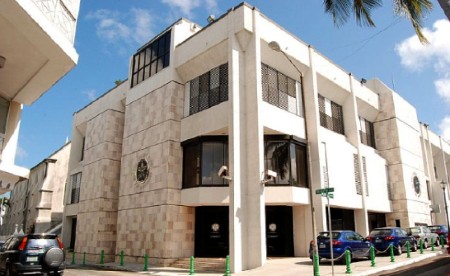NASSAU, Bahamas –The Bahamian economy exhibited a measured pace of recovery during 2021, the Central Bank of the Bahamas (CBB) has said.
 Central Bank of the Bahamas.In its just released 2021 Annual Report, the CBB said that the domestic economy registered a growth of 13.7 percent last year, following a coronavirus (COVID-19) pandemic-related 23.8 percent contraction in 2020.
Central Bank of the Bahamas.In its just released 2021 Annual Report, the CBB said that the domestic economy registered a growth of 13.7 percent last year, following a coronavirus (COVID-19) pandemic-related 23.8 percent contraction in 2020.
“Amid widespread vaccination efforts and the gradual easing of globally imposed travel restrictions, a recovery commenced in tourism output, led by a rebound in the high value-added air segment and joined later in the year by a restart of cruise activity.
“Several varied-scaled foreign investment-led projects and to a lesser extent continued post-hurricane reconstruction works, provided support to the construction sector, and by extension to economic growth.”
The Central Bank said that average consumer prices firmed during the year, reflecting the pass-through effects of higher global oil prices and other costlier imports.
It said that indications are that unemployment remained above pre-COVID levels, though significant workforce re-engagement began in the tourism plant, with impact also from sustained construction activities.
The CBB said that the fiscal deficit-to-gross domestic product (GDP) ratio rose to an estimated 12.8 percent in financial year 2020-21 from 7.2 percent in the previous financial year, as the tax base contracted over the height of the lockdown, while expenditure growth was necessary on health sector infrastructure and social services associated with the pandemic, combined with outlays still for the reconstruction of key infrastructure, following the 2019 major hurricane.
At the end of December last year, the Government’s Direct Charge-to-GDP ratio firmed to an estimated 92.1 percent from 97.1 percent in 2020. The National Debt-to-GDP ratio stood at an estimated 95.6 percent at end-December, a decrease of six percentage points over the 12-month period.
The Central bank said that external reserves expanded by US$50.6 million or 2.1 percent to US $2,432.8 million during the year, a moderation from the US$624.1 million (35.5 percent) accumulation in the preceding period, which had included net proceeds from government’s external borrowings. It said the import cover ratio narrowed to 36.8 weeks, from 56.8 weeks in 2020, but exceeded the 12 weeks benchmark.
The Bahamian Dollar Digital Currency Regulations, 2021 were gazetted and passed into law in November, 2021. Along with progress on the technology platform, this has set the stage for a more accelerated push for national adoption of the Sand Dollar in 2022, the CBB said.
“With the improving outlook for tourism inflows, the foreign exchange conservation measures that were implemented at the start of the pandemic were relaxed in 2021. The moratorium placed on the consideration of new license applications for payment services providers and money transmission businesses remained in effect during the year, and is expected to be extended through to September, 2022.”
The CBB said that the credit bureau transitioned to live operations on 30th April, 2021, marking the onset of data submission to the bureau by domestic lending institutions.
The annual report, which provides an examination of the economic and financial environment, locally and internationally, the CBB said that global lockdowns to contain the spread of the coronavirus (COVID-19) eased, given aggressive vaccine campaigns, resulting in a rebound in the tourism sector, albeit still below pre-COVID-19 levels.
“The strengthening in tourism output was mostly supported by the rebound in the high value-added air segment. A seasonal upswing in sea traffic was also noted, though restarting at a much later point during the calendar year, and with more deliberately constrained occupancy rates,” said CBB Governor John A. Rolle.
He said in addition, a number of small to medium-scale foreign investment projects undergirded activity in the construction sector.
“As private sector lending conditions remained subdued, monetary developments featured further build-up in both bank liquidity and external reserves. However, the pass through inflows to both aggregates from public sector debt operations were moderated, as the Government’s external borrowings narrowed in comparison to 2020.”
The CBB said that although credit quality metrics weakened further, given the pandemic’s continuing influence, the adjustment was more tempered, with losses related to bad debt provisioning also significantly curtailed.
According to the Central Bank, in the fiscal sector, the deficit widened significantly for the financial year 2020-21 as the COVID-19 related disruption in economic activities led to a falloff in revenue collections.
“However, for the first half of financial year 2021-22, the deficit narrowed considerably, underpinned by a value added tax (VAT)-led growth in total revenue, which outweighed the expansion in aggregate expenditure,” Rolle said.


